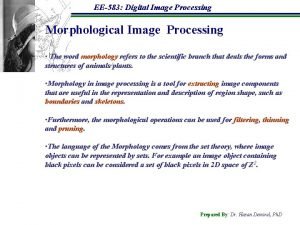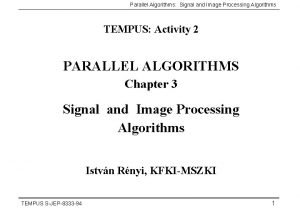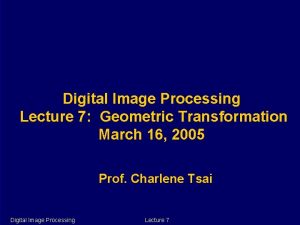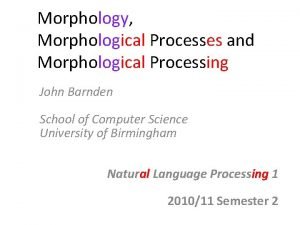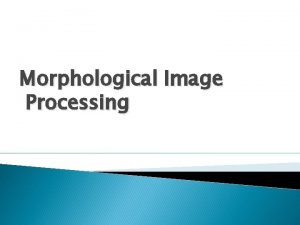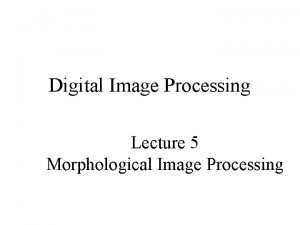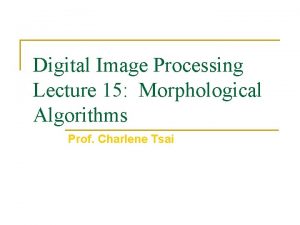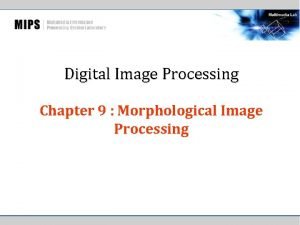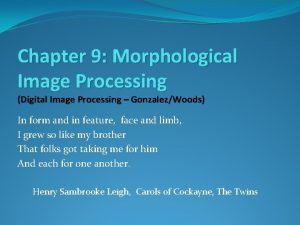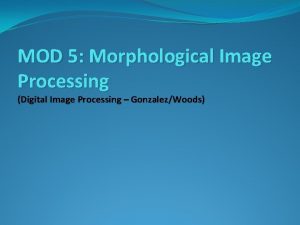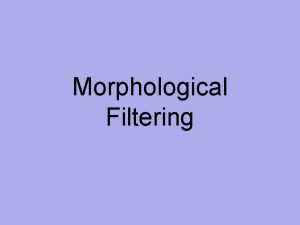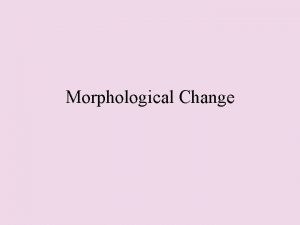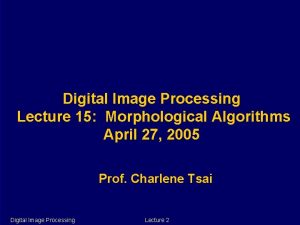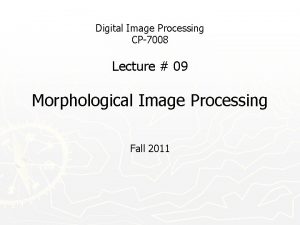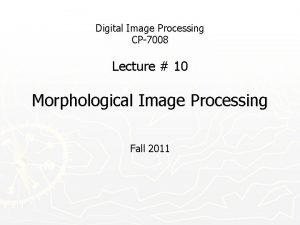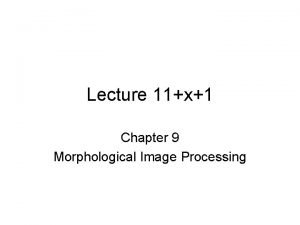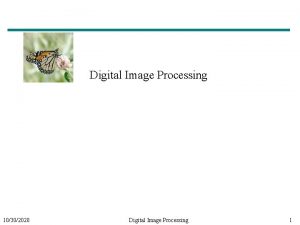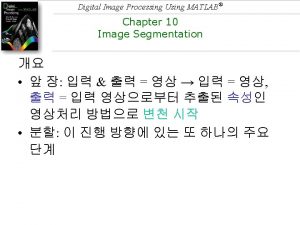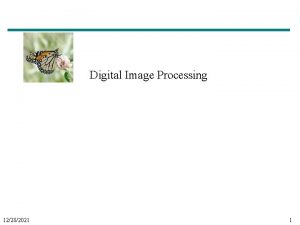Digital Image Processing Lecture 15 Morphological Algorithms Prof























- Slides: 23

Digital Image Processing Lecture 15: Morphological Algorithms Prof. Charlene Tsai

Before Lecture … n Solution to previous quiz: all erosions 2

Overview n n Extracting image components that are useful in the representation and description of shape. We’ll consider: q q Boundary extraction Region filling Extraction of connected components Skeletonization 3

Boundary Extraction n Denote the boundary of set A by Step 1: eroding A by the structuring element B Step 2: taking the difference between A and its erosion. 4

Another Illustration Using B as the structuring element, so boundary is 1 pixel thick. 5

Region Filling n n A is a set containing a subset whose elements are 8 -connected boundary points of a region. Goal: fill the entire region with 1’s. 6

Region Filling (con’d) Final Terminate when Xk=Xk-1 7

Some Remarks n n The dilation process would fill the entire area if left unchecked. limits the result to inside the region of interest. Conditional dilation Applicable to any finite number of such subsets, assuming that a point inside each boundary is given. 8

Connected Components n n Extraction of connected components in a binary image is central to many automated image analysis applications. Let Y be a connected component in set A and p a point of Y. 9

Application of Connected Component 10

Skeletonization n n We have seen some algorithms for skeletonization when discussing topology. Review: skeleton of a binary object is a collection of lines and curves that describe the size and shape of the object. Different algorithms and many possible different skeletons of the same object. Here we use a combination erosion and opening operations 11

(con’d) Formulation: with where k time The big K is the last iterative step before A erodes to an empty set. 12

Skeletonization: Demo Final skeleton 13

Grayscale Morphology – Dilation (Advance) n General formulation: n where f is the grayscale image and b is the structuring element. In other words, the value of dilation at (x, y) is the maximum of the sum of f and b in the interval spanned by b. 14

Example 1 2 3 4 5 (x) 1 10 20 20 20 30 2 20 30 30 40 50 3 20 30 30 50 60 4 20 40 50 50 60 5 30 50 60 60 70 (y) What is -1 0 1 -1 1 2 3 0 4 5 6 1 7 8 9 b f ? 15

Effect of Dilation n Two effects: q q If all values of the structuring element are positive, the output image tends to be brighter. Dark details either are reduced or eliminated, depending on how their values and shapes relate to the structuring element. 16

Grayscale Morphology - Erosion 1 2 3 4 5 (x) 1 10 20 20 20 30 2 20 30 30 40 50 3 20 30 30 50 60 4 20 40 50 50 60 5 30 50 60 60 70 (y) 0 1 -1 1 2 3 0 4 5 6 1 7 8 9 b f What is -1 ? 17

Demo 18

Opening & Closing Opening: Closing: 19

Demo original 20

Application: Granulometry n Definition: determining the size distribution of particles in an image q q Useful when objects are overlapping and clustered. Detection of individual particles are hard. 21

(con’d) n n n Opening operations with structuring elements of increasing size are performed on the original image. Motivation: opening operations of a particular size have the most effect on regions containing particles of similar size. Method: q q For every structuring element, compute the difference btw the Im-1 and Im, where m is the index of the structuring element. At the end, normalize the differences => a histogram of particle-size distribution 22

Demo 23
 Digital image processing
Digital image processing Histogram processing in digital image processing
Histogram processing in digital image processing Neighborhood processing in image processing
Neighborhood processing in image processing Laplacian filter
Laplacian filter What is point processing in digital image processing
What is point processing in digital image processing Image enhancement by point processing
Image enhancement by point processing Ee583
Ee583 Image transform in digital image processing
Image transform in digital image processing Optimum notch filter in image processing
Optimum notch filter in image processing Compression in digital image processing
Compression in digital image processing Image segmentation in digital image processing
Image segmentation in digital image processing Lossless image compression matlab source code
Lossless image compression matlab source code Image sharpening in digital image processing
Image sharpening in digital image processing Geometric transformation in digital image processing
Geometric transformation in digital image processing Isopreference curve
Isopreference curve Image transform in digital image processing
Image transform in digital image processing Imtransform matlab
Imtransform matlab Image restoration in digital image processing
Image restoration in digital image processing Parallel image processing algorithms
Parallel image processing algorithms Image processing lecture notes
Image processing lecture notes Fluorocein
Fluorocein Analysis of algorithms lecture notes
Analysis of algorithms lecture notes Introduction to algorithms lecture notes
Introduction to algorithms lecture notes Example of morphological process
Example of morphological process






